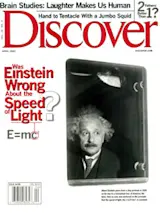Films
The Core Directed by Jon AmielParamount PicturesOpens March 28, 2003
Earth's core has stopped rotating. A collapse of the planet's magnetic field is imminent. Migrating birds circle madly, electronic devices go haywire, and the worst is yet to come: If the field fails entirely, charged subatomic particles from space will crash down unfettered, spawning giant lightning storms and eventually frying the planet's surface. Somehow, humans have to travel 1,700 miles down to the core and get it moving again.
Microwaves from the sun wreak havoc on the Golden Gate Bridge in The Core. It is a gripping scene but one of the less credible moments in a movie that generally pays a lot of respect to the spirit of science.
Photograph courtesy of Paramount Pictures.
This is the premise of The Core, an inventive and tautly paced reworking of the old science-fiction disaster movie. Much of the fun comes ...














